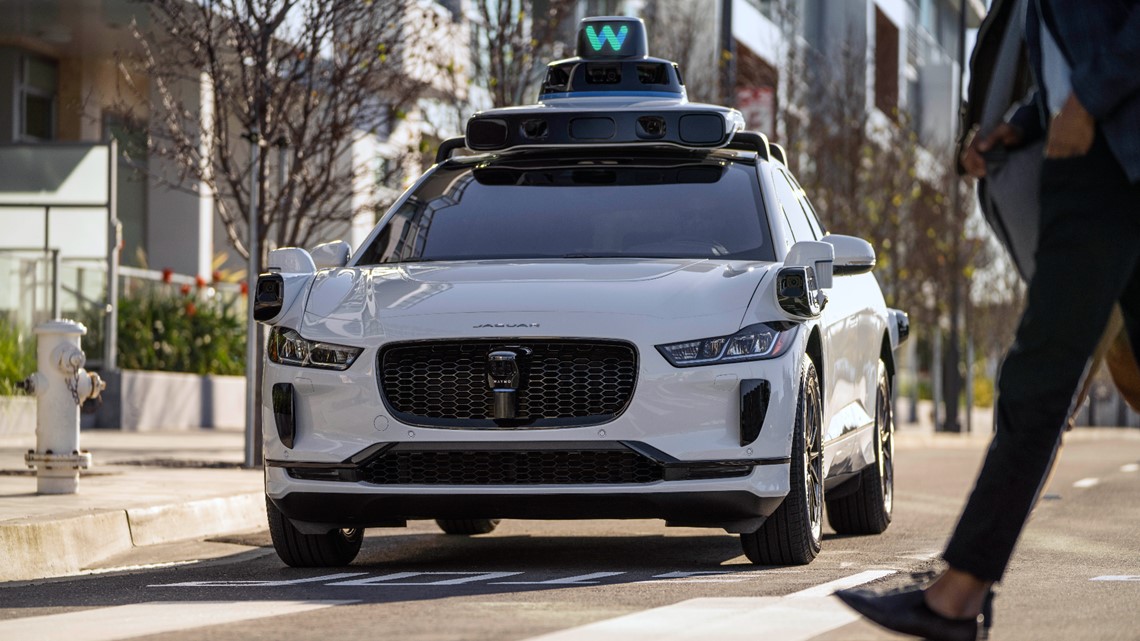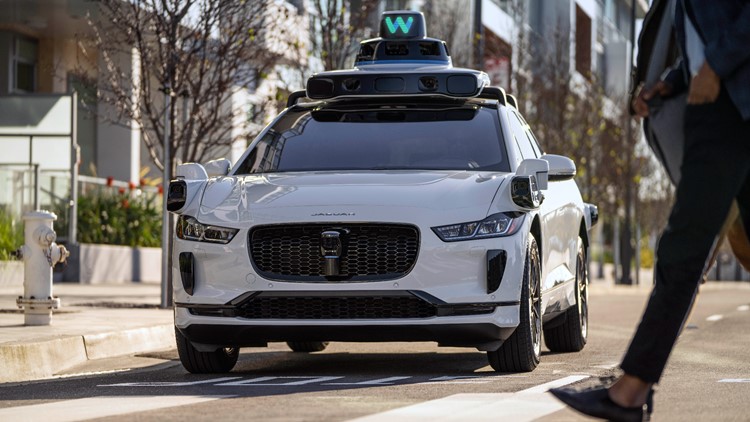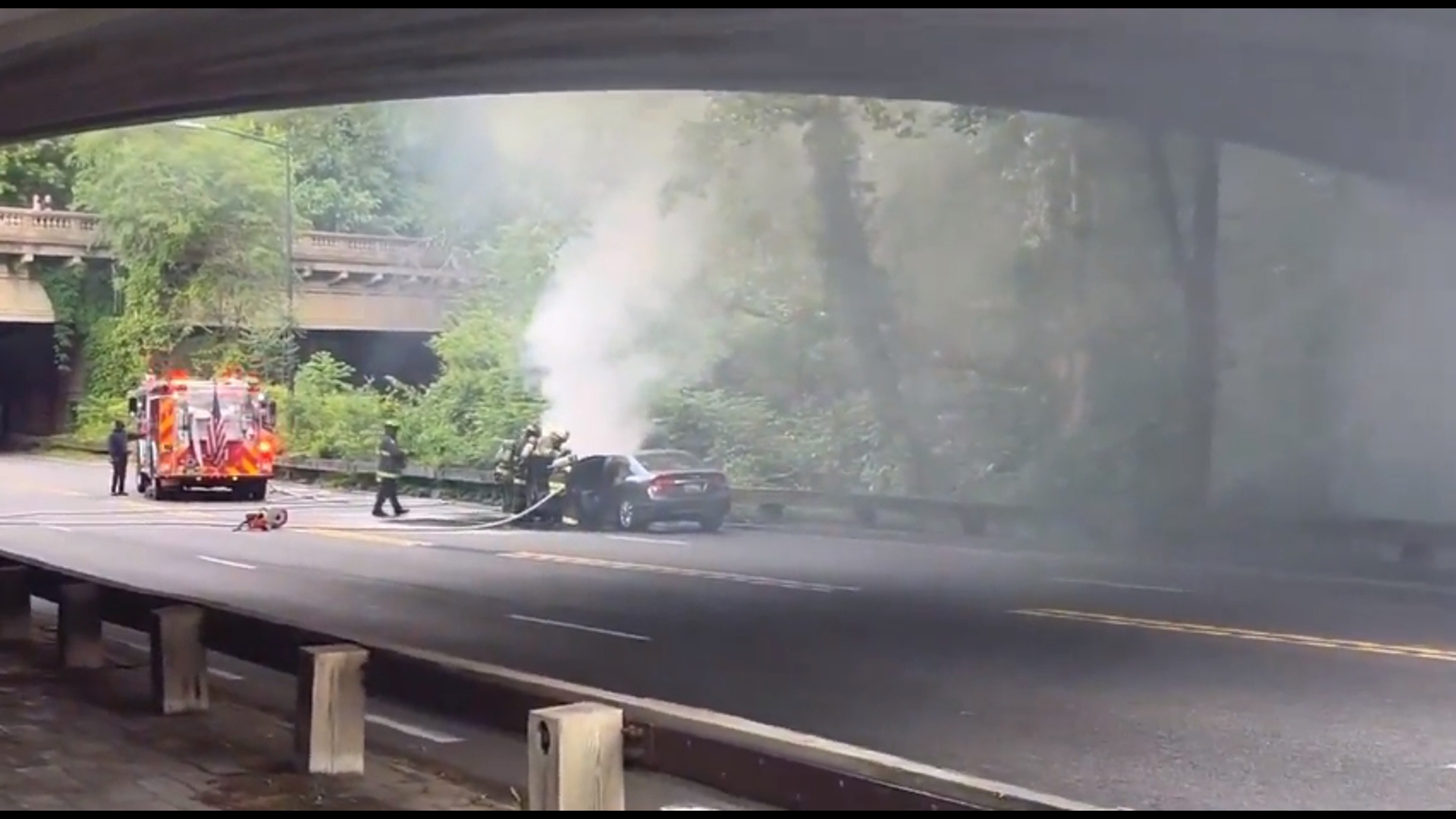WASHINGTON — Waymo, the autonomous vehicle company owned by Google parent Alphabet, has begun data collection in D.C. as part of a cross-country training program for its self-driving cars.
D.C. residents may have already seen the company’s vehicles – all-electric Jaguar I-Pace sedans outfitted with sensing equipment on the exterior of the vehicle – driving around the city. In an interview with WUSA9, Waymo product manager Nick Rose said the vehicles are primarily being tested for now in corridors like Dupont Circle, Foggy Bottom and Penn Quarter, and that there are no plans to operate in Maryland or Virginia. The vehicles are all being driven manually by Waymo employees who have been trained as test drivers.
“Their job is to teach Waymo how to drive in new cities and what to do and not to do,” Rose said. “In D.C., if you see one of our cars being driven around, it’s either being entirely (manually) driven or it’s in autonomous mode with a driver ready to hit the button and say, no, that’s not what you should do. And then we take that data back and we use it to make our software better.”
In autonomous, or self-driving, mode, the cars are driven by the Waymo Driver – which the company bills as the “world’s most-experienced driver.” Rose says the technology has been honed over millions of miles already driven on public roads.
“When we talk about the (Waymo) Driver, what we mean is a software that is able to navigate the car across a vast array of use cases and environments,” Rose said.


The Waymo Driver works by constantly reading in sensor data 360 degrees around the vehicle and using computer modeling to determine how best to navigate any given situation.
“What’s the car next to you going to do, what’s the mother with the stroller going to do?” Rose said. “And then what you have to do is, you have to plan. How should this car navigate this street? How should it go around this vehicle? That’s basically what the car has to do.”
In 2020, D.C. overhauled a 2013 law that allowed the DMV to create an autonomous vehicle designation and directed the Department of Transportation to instead create a program to allow companies to test AVs in the District. The city council passed additional emergency legislation earlier this year establishing an interim testing process. The law requires companies that seek permits to test in the District to submit a safety and risk mitigation assessment that includes cybersecurity risks, to show their vehicles will capture and store sensor data in the event of a crash, and to prove the company has $5 million in liability coverage in the cash of property damage, personal injury or death caused by the vehicle. AVs are also only allowed to operate in the District with a trained driver physically present in the vehicle.
In September, Cruise, General Motors’ autonomous vehicle subsidiary, tested several of its vehicles in D.C. Another company, the now-defunct Ford-backed Argo AI, has also previously tested autonomous vehicles in D.C. In a statement to WUSA9, a DOT spokesperson confirmed Waymo had been permitted to test as well:
“The District Department of Transportation (DDOT) continues its commitment to establishing a permitting program to test autonomous vehicles (AVs) in the city. Per the recently enacted Autonomous Vehicle Testing Permit Requirement Amendment Act of 2024, Waymo has notified DDOT that they are conducting data collection activities across the District this spring and summer. As per the law, the vehicles will always have a safety operator. Waymo will conduct data collection efforts with a small fleet of fewer than ten vehicles.
“DDOT’s permitting program will focus on ensuring that any AV testing on DC’s streets can be done safely and that the testing will be monitored in a way that enables ongoing learning and adjustments.”
Waymo currently offers ride-hailing services with AVs in three metros: San Francisco, Los Angeles and Phoenix. Combined, Rose said, the company provides thousands of rides a day without a human driver present. Last month, the company said it would begin offering driverless passenger services for its employees in Austin, Texas, in preparation for rolling out services to the public later this year.
While Rose said Waymo expects D.C. would be, like San Francisco, a “high-demand” city for self-driving rideshares, public opinion polling nationally has consistently found Americans skeptical to the idea of driverless vehicles. A poll conducted by Pew Research Center in November 2021 found 44% of respondents thought widespread use of autonomous vehicles was a “bad idea” for society, versus only 26% who thought it was a good idea. And 63% of respondents said they would not want to ride in a driverless vehicle. Men, younger respondents and those with college or post-graduate degrees were more likely to say they would be willing to give self-driving vehicles a chance.
Autonomous vehicle companies like Waymo and Cruise market themselves as safer options compared to human-driven vehicles.
“Part of the reason this company was founded was based on the belief that we could build a safer driver,” Rose said.
On its website, Waymo boasts that over 7 million miles the Waymo driver produced an 85% reduction in injury-causing crashes and a 57% reduction in police-reported crashes.
Under a standing order from the National Highway Traffic Safety Administration (NHTSA), autonomous vehicle companies must report any crash if any automated driving system (ADS) was in use at any time within 30 seconds of the crash and the crash resulted in property damage or injury.
According to NHTSA data, in 2023 AVs were involved in 291 crashes across the country, of which 271, or 93%, involved no injuries. Waymo, which currently operates more than 400 AVs nationwide, accounted for 86 of those crashes – of which only two resulted in minor injuries. Waymo claims to have provided more than 700,000 driverless trips last year.
By comparison, a WUSA9 analysis of data from the D.C. Department of Transportation found human drivers were involved in nearly 4,300 crashes in the District last year – 21% of which, or 900, resulted in some sort of injury. Thirty-nine people were killed in car crashes in D.C. in 2023.
Waymo vehicles have been involved in at least two crashes that garnered significant public attention. In February, the company issued a recall and performed a software update on its entire U.S. fleet after a December incident in Phoenix when two Waymo AVs struck the same pickup truck. According to WUSA9’s sister station 12News in Phoenix, neither Waymo was carrying passengers at the time and the truck was being towed.
A Waymo AV was also attacked and set on fire by a crowd in San Francisco earlier this year after it entered a blocked intersection during Chinese New Year celebrations, according to Reuters. The attack came weeks after a Waymo AV collided with a cyclist in the city.
GM’s Cruise self-driving service is now the subject of multiple investigations, including one launched the Department of Justice, into a separate incident in San Francisco in which one of its vehicles struck a pedestrian and dragged them 20 feet. GM recalled all 950 of its Cruise vehicles for a software update in November following that collision, according to CBS News, and Cruise leadership released an open letter last month apologizing for how the company handled the incident. Following the crash, California regulators revoked Cruise’s license to operate in the state.
Study: AVs Mean More Growth (And More Congestion)
In 2020, an autonomous vehicles study report commissioned by DC Sustainable Transportation and prepared by the consulting firm AECOM looked at the potential impacts of AVs and connected vehicles (CVs) in the D.C. region.
The report described the introduction of AVs into the D.C. metro area as a when, not if, question, and proposed four scenarios for how the region could adapt to the change. It also forecast the potential positive benefits of widespread AV adoption in the region, among them increased economic growth better housing affordability as land dedicated for parking could be reclaimed and reused to create more walkable urban areas. Another benefit highlighted by the report: the possibility AVs could help D.C. achieve its Vision Zero goal to eliminate traffic deaths and serious injuries. Despite a decrease in the number of collisions during the pandemic, the city has not achieved its Vision Zero goals. Last year, 39 people were killed in traffic collisions – the highest number since 2015. More than 500 cyclists were also involved in collisions with vehicles last year, exceeding the totals of each of the previous three years.
Rose said San Franciso has a similarly robust cycling community as D.C. He said Waymo prides itself in how it interacts with cyclists, which he called an area of focus for the company.
“One of the things you’ll see us doing when we’re riding alongside a protected bike lane with a cyclist is kind of nudge over, respectfully, like a human would,” Rose said. “I like cycling too, and I tend to feel a little safer around Waymo vehicles because they have that 360-degree field of view and they’re paying attention all the time. And I cannot say the same about human drivers.”
The autonomous vehicles study report also predicted AVs would have a number of negative impacts on the District. In particular, every scenario considered in the report resulted in increased congestion in response to both passengers choosing AVs over public transit and the need for AVs to travel empty while relocating between passengers. The report repeatedly emphasized the need for the D.C. area to look at strategies to minimize the increase in car trips, including prioritizing high-occupancy travel with more dedicated lanes and, in particular, the imposition of congestion fees during peak travel hours.
Even without fleets of AVs, other cities around the country have already looked toward congestion pricing to ease the burden on overcrowded streets. On Wednesday, New York City’s Metropolitan Transportation Authority (MTA) approved the first congestion pricing program in the U.S. Beginning in June, the city will impose tolls of $15 for cars entering Manhattan below 60th Street during the day. Trucks entering the same area will pay between $24-$36, and taxi and rideshare drivers will also see increased fees. The MTA hopes the program will result in 100,000 fewer vehicles entering the congestion relief zone every day.
Congestion pricing has been repeatedly suggested for D.C. as well. Earlier this year, the D.C. City Council’s Public Works & Operations Committee recommended establishing a For-Hire Vehicle Congestion Management Program that would levy a $2 fee on all “digital dispatch rides” – that is, trips booked through rideshare apps like Uber and Lyft – entering the Central Business District during peak traffic hours. The committee’s proposal would exclude wheelchair accessible rides from paying the additional fee.
In 2020, the city budget funded a decongestion pricing study to make recommendations about road and bridge pricing policies. The results of that study have not been released publicly.
Aside from increased congestion, the AV study also predicted a potentially significant loss in revenue – specifically from parking and speeding camera fines which, combined, generate more than $350 million a year for the city. The congestion fee proposed in the study was estimated to potentially make up some of that revenue or even exceed it during early years of AV adoption.
The report also predicted AVs would likely threaten jobs in certain industries, including “drivers of all types, parking attendant and enforcement jobs, gas station employees, or even personal injury lawyers.” Those job losses would likely by offset, the report said, by growth in other industries like programming, computer systems and mechanical technicians.


